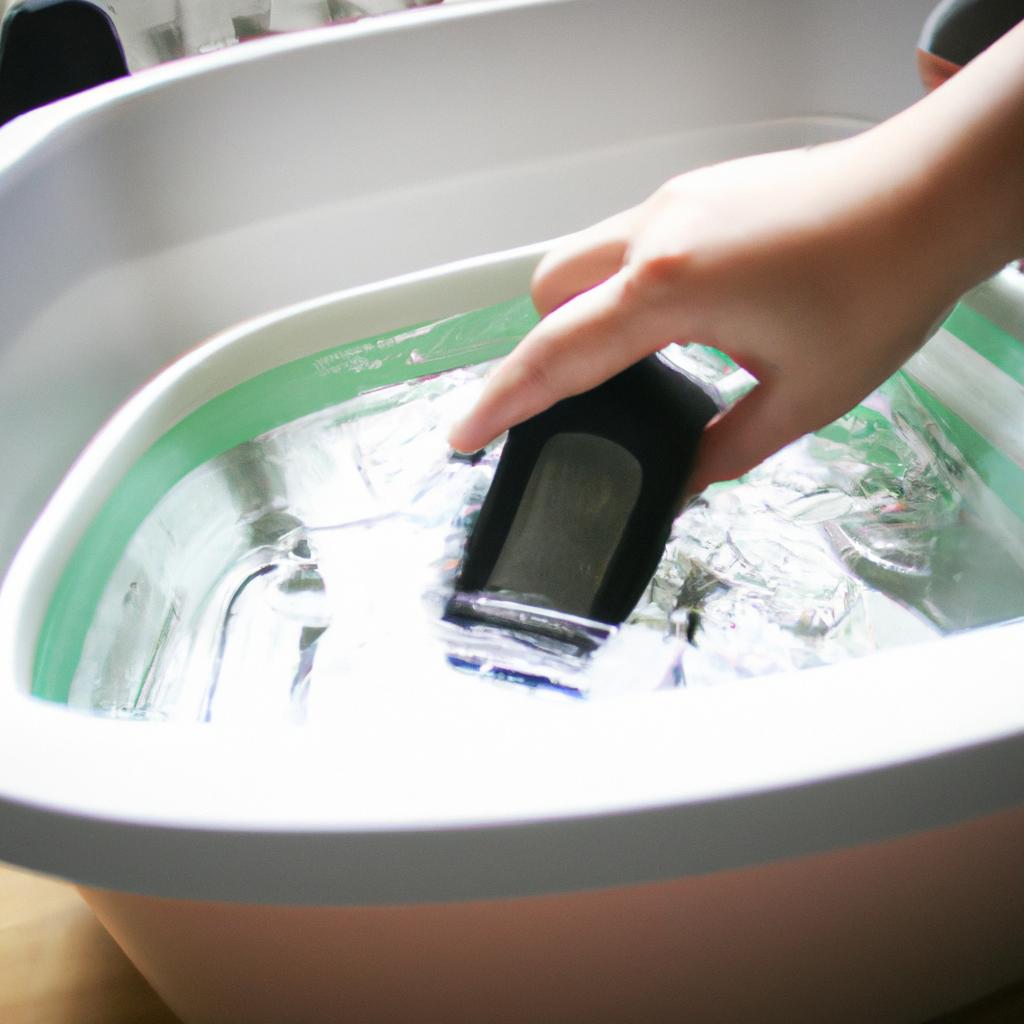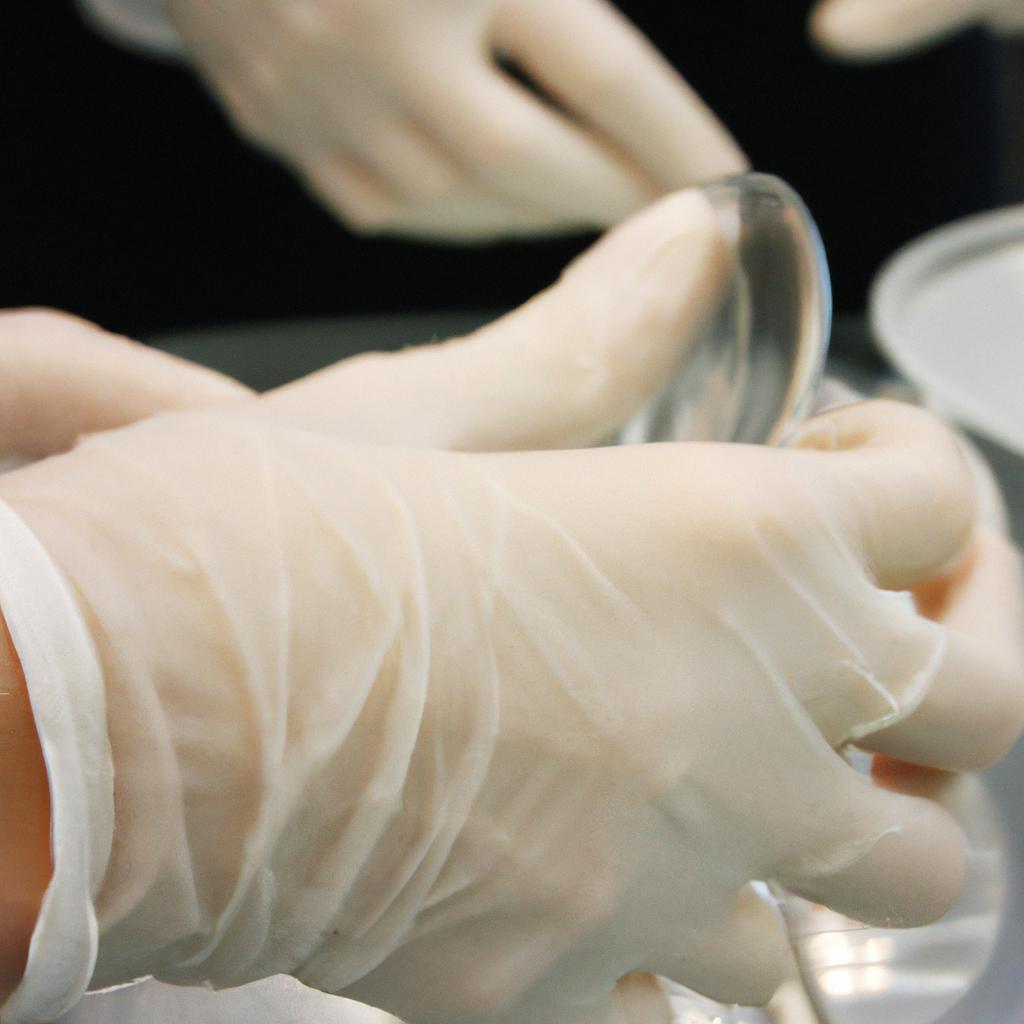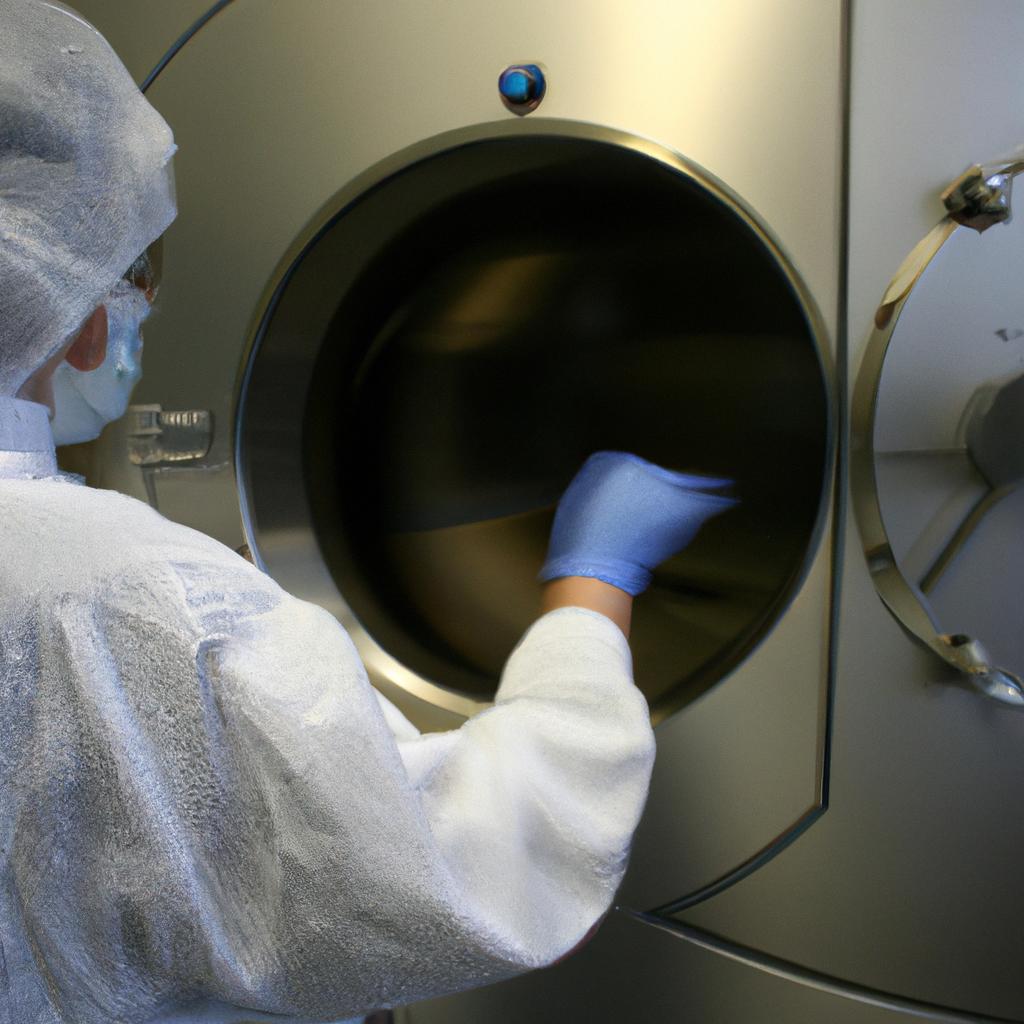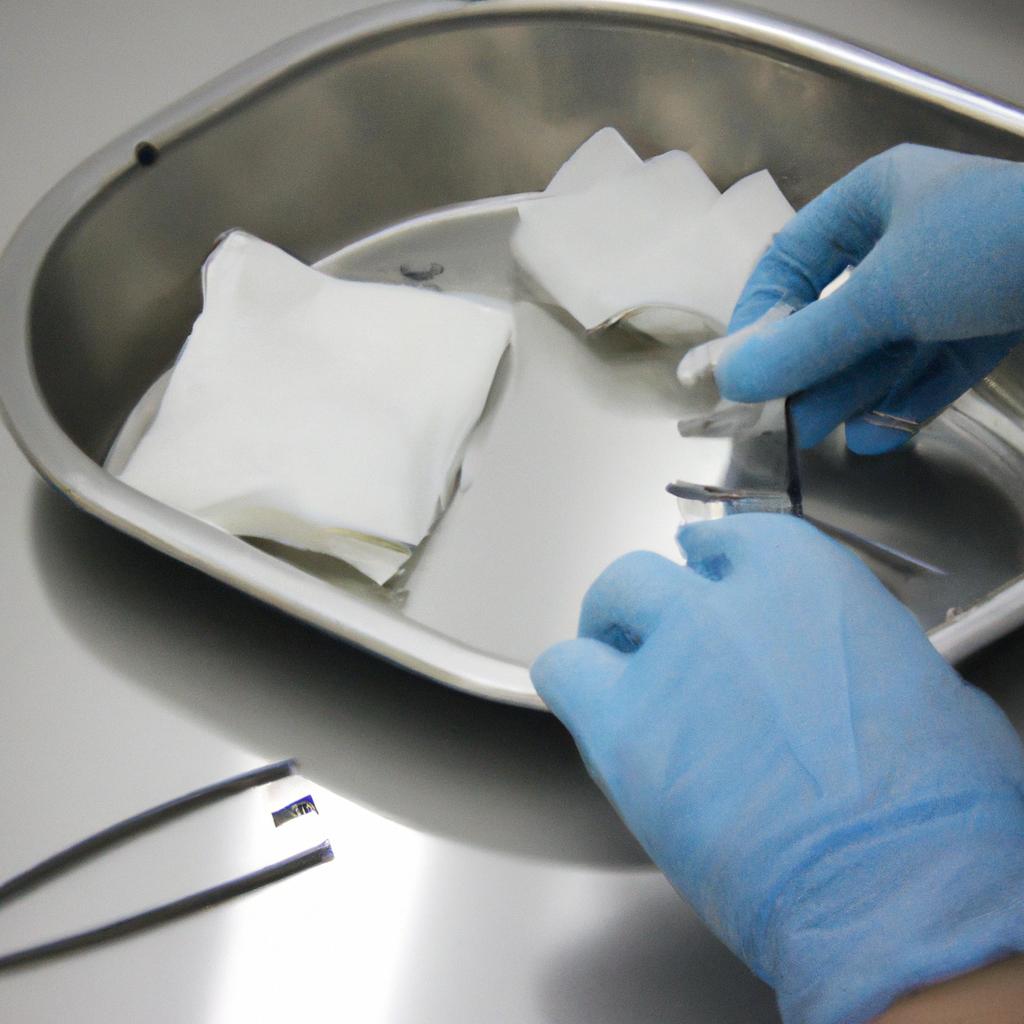Ultrasonic cleaners have become essential tools in the field of healthcare for effectively cleaning and sterilizing instruments. These devices utilize high-frequency sound waves to generate microscopic bubbles that create intense agitation, removing even the most stubborn contaminants from surfaces. For instance, imagine a scenario where a surgical instrument used during a complex procedure becomes contaminated with blood or bodily fluids. Traditional methods of manually scrubbing and soaking may not be sufficient to fully remove these contaminants, potentially compromising patient safety. In such cases, ultrasonic cleaners offer a highly efficient and reliable solution by providing thorough cleaning and sterilization.
The use of ultrasonic cleaners has revolutionized instrument cleaning and sterilization processes due to their ability to reach areas that are difficult to access using manual techniques alone. This technology is particularly crucial in healthcare settings where infection control plays a vital role in ensuring patient safety. By immersing the instruments into an ultrasonic bath filled with a specialized detergent solution, the microscopic bubbles produced by the device penetrate hard-to-reach crevices on the surface of the instruments, dislodging any debris or biofilms present. Additionally, as the bubbles collapse against the instrument’s surface, they release energy that further assists in removing contaminants effectively.
In conclusion, ultrasonic cleaners have emerged as indispensable tools in the field of healthcare for their ability to efficiently clean and sterilize instruments. Their use has greatly improved infection control measures, ensuring patient safety during surgical procedures and other medical interventions. With their high-frequency sound waves and generation of microscopic bubbles, ultrasonic cleaners can effectively remove even the most stubborn contaminants from instrument surfaces, reaching areas that are difficult to access manually. This technology has revolutionized the cleaning and sterilization processes, providing a reliable solution for maintaining the highest standards of cleanliness in healthcare settings.
Understanding Ultrasonic Cleaners
Imagine a dental clinic that has just completed a long and intricate root canal procedure. The dentist, Dr. Smith, meticulously cleans the instruments used in the procedure by scrubbing them with soap and water. He then places them in an ultrasonic cleaner for further sterilization. Within minutes, the instruments emerge sparkling clean and free from any remaining debris or contamination.
Ultrasonic cleaners have become essential tools in various industries, including healthcare, manufacturing, and electronics. These devices use high-frequency sound waves to create microscopic bubbles that rapidly collapse upon contact with surfaces. This phenomenon, known as cavitation, generates powerful cleaning action capable of reaching even inaccessible areas of complex equipment.
- Efficiently removes stubborn stains and contaminants
- Reduces manual labor involved in cleaning processes
- Ensures consistent and thorough cleaning results
- Enhances overall hygiene standards and reduces infection risks
In addition to their versatility and effectiveness, ultrasonic cleaners also offer several advantages over traditional cleaning methods. A three-column table outlining these benefits would be as follows:
| Benefit | Description | Example |
|---|---|---|
| Time-saving | Rapidly cleans multiple objects simultaneously | Cleaning surgical instruments |
| Non-abrasive | Safely cleans delicate materials without damage | Cleaning jewelry or optical lenses |
| Environmentally friendly | Uses biodegradable detergents instead of harsh chemicals | Cleaning automotive parts |
As we delve deeper into understanding how ultrasonic cleaners work, it becomes evident why they are widely adopted across various industries. By harnessing the power of sound waves through cavitation, these devices effectively remove dirt and contaminants while minimizing manual effort.
Transitioning seamlessly into the subsequent section on “How Ultrasonic Cleaners Work,” we will explore the underlying principles and mechanisms that make these devices such invaluable assets in the field of cleaning and sterilization.
How Ultrasonic Cleaners Work
In the previous section, we explored the concept of ultrasonic cleaners and their importance in instrument cleaning and sterilization. Now, let’s delve deeper into how these powerful devices work to achieve thorough cleanliness.
Imagine a dental clinic where various instruments are used daily. One such instrument is a set of dental drills that require meticulous cleaning after each use to prevent cross-contamination between patients. Traditionally, manual scrubbing and soaking were employed for this purpose. However, with the introduction of ultrasonic cleaners, the process has become more efficient and effective.
Ultrasonic cleaners utilize high-frequency sound waves to create microscopic bubbles in a cleaning solution. These tiny bubbles implode upon contact with surfaces, generating intense heat and pressure that dislodges contaminants from instruments’ crevices. This phenomenon, known as cavitation, allows for superior removal of debris compared to conventional methods.
To better understand the benefits of ultrasonic cleaners, consider the following:
- Enhanced Cleaning Efficiency: The unique action of ultrasonic cleaners ensures that even hard-to-reach areas on complex instruments are thoroughly cleaned.
- Time-saving: With automated processes and reduced reliance on manual labor for scrubbing or soaking, healthcare professionals can allocate their time more effectively.
- Improved Infection Control: By eliminating microorganisms at a microscopic level through cavitation, ultrasonic cleaners contribute significantly to maintaining a sterile environment.
- Extended Instrument Lifespan: Proper cleaning using ultrasonic technology helps preserve delicate instrument components by reducing wear caused by abrasive scrubbing.
| Benefit | Description |
|---|---|
| Enhanced Cleaning Efficiency | Thoroughly cleans even intricate parts |
| Time-saving | Automates the cleaning process |
| Improved Infection Control | Eliminates microorganisms at a microscopic level |
| Extended Instrument Lifespan | Reduces wear and tear caused by traditional scrubbing |
As we have seen, ultrasonic cleaners offer numerous advantages for instrument cleaning and sterilization. By understanding how ultrasonic cleaners can revolutionize cleanliness practices, we can better appreciate their value in various settings.
Next Section: Benefits of Ultrasonic Cleaners
Benefits of Ultrasonic Cleaners
Imagine a dental clinic that has just performed a complex root canal procedure. Once the instruments have been used, they need to be thoroughly cleaned and sterilized before being reused on another patient. This is where ultrasonic cleaners come into play – these powerful machines utilize high-frequency sound waves to achieve deep cleaning and efficient sterilization.
Ultrasonic cleaners work by creating microscopic bubbles in a liquid cleaning solution through a process called cavitation. These bubbles collapse rapidly, producing intense shockwaves that dislodge dirt, debris, and microorganisms from the surfaces of instruments. The combination of the cleaning solution’s chemical action and the mechanical force generated by cavitation ensures thorough removal of contaminants, even from hard-to-reach areas.
The benefits of using ultrasonic cleaners for instrument cleaning are numerous:
- Superior Cleaning Efficiency: The microscopic bubbles created during cavitation can reach crevices that manual scrubbing or conventional cleaning methods might miss.
- Time-Saving: Ultrasonic cleaning reduces the overall time required for instrument processing compared to traditional methods.
- Improved Safety: By effectively removing contaminants, ultrasonic cleaning helps reduce the risk of cross-contamination between patients.
- Prolonged Instrument Life: Regular use of ultrasonic cleaners can help extend the lifespan of delicate instruments by minimizing harsh handling or abrasive scrubbing.
To illustrate this further, here is an example scenario showcasing how an ultrasonic cleaner could benefit healthcare professionals:
Case Study:
Dr. Smith operates a busy orthopedic clinic where surgical instruments are constantly in demand. Before adopting an ultrasonic cleaner, Dr. Smith’s staff had to spend significant amounts of time manually scrubbing each instrument individually. This not only took up valuable resources but also posed challenges in ensuring complete cleanliness. However, after introducing an ultrasonic cleaner into their workflow, the staff noticed remarkable improvements in both efficiency and effectiveness. Not only were they able to clean multiple instruments simultaneously, but the ultrasonic cleaner’s cavitation process ensured thorough removal of contaminants from even the most intricate surgical tools.
In summary, ultrasonic cleaners offer a scientifically proven method for achieving deep cleaning and sterilization. By harnessing the power of high-frequency sound waves, these machines provide superior efficiency, time-saving benefits, improved safety, and increased instrument longevity.
Choosing the Right Ultrasonic Cleaner
Imagine a dental clinic that needs to clean and sterilize its instruments efficiently and effectively. They have been using traditional manual cleaning methods for years, but they are looking for a more advanced solution to improve their workflow. This is where ultrasonic cleaners come into play. These powerful machines utilize ultrasonic waves to remove contaminants from various materials, making them essential tools in instrument cleaning and sterilization.
Ultrasonic cleaning technology offers several advantages over conventional cleaning methods. Firstly, it provides thorough and consistent cleaning by reaching even the most intricate parts of complex instruments such as dental drills or surgical scissors. The high-frequency sound waves create millions of microscopic bubbles in the cleaning solution, which implode upon contact with surfaces, dislodging dirt particles from hard-to-reach areas. This ensures that all contaminants are thoroughly removed, leaving instruments pristine and ready for use.
In addition to superior cleanliness, ultrasonic cleaners offer time-saving benefits. Compared to manual scrubbing or soaking processes, which can be labor-intensive and time-consuming, these machines significantly reduce the overall cleaning time required. Dental clinics can save valuable hours each week by utilizing an ultrasonic cleaner instead of relying solely on manual techniques.
Moreover, using an ultrasonic cleaner enhances safety protocols within healthcare settings. Properly cleaned and sterilized instruments are crucial in preventing cross-contamination between patients and reducing the risk of infections or complications during procedures. By incorporating ultrasonic cleaners into their instrument reprocessing routine, dental clinics can ensure compliance with strict hygiene regulations and maintain a safe environment for both patients and staff.
*Benefits of Ultrasonic Cleaners:
- Thorough and consistent cleaning
- Time-saving capabilities
- Enhanced safety protocols
| Benefit | Description |
|---|---|
| Thorough and Consistent Cleaning | Ultrasonic waves reach every nook and cranny of complex instruments |
| Time-Saving Capabilities | Significantly reduces overall cleaning time, improving workflow and efficiency |
| Enhanced Safety Protocols | Ensures compliance with hygiene regulations, preventing cross-contamination and reducing the risk of infections or complications |
Understanding the advantages offered by ultrasonic cleaners is essential for dental clinics and other healthcare facilities seeking to optimize their instrument reprocessing procedures. However, simply acquiring an ultrasonic cleaner does not guarantee optimal results. In the following section, we will explore best practices for utilizing these machines effectively to maximize their potential in achieving exceptional cleanliness and sterilization outcomes.
Transitioning into the subsequent section about “Best Practices for Using Ultrasonic Cleaners,” let’s delve deeper into how to harness the power of ultrasonic cleaning technologies.
Best Practices for Using Ultrasonic Cleaners
Case Study:
Imagine a dental clinic that is committed to providing the highest level of patient care. They have invested in state-of-the-art ultrasonic cleaners to ensure thorough instrument cleaning and sterilization. However, without proper knowledge and adherence to best practices, even the most advanced equipment can fail to deliver optimal results.
To make the most out of an ultrasonic cleaner and maximize its effectiveness, it is crucial to follow these best practices:
-
Pre-Cleaning: Before placing instruments into the ultrasonic cleaner, they should undergo pre-cleaning by removing visible debris such as blood or tissue. This step ensures that the cleaning solution can penetrate deeply into hard-to-reach areas during the ultrasonic process.
-
Proper Loading: Careful consideration must be given to how instruments are loaded into the ultrasonic cleaner’s basket or tray. Overcrowding can impede effective cleaning, while leaving too much space between items may lead to inadequate coverage. A balanced loading technique should be employed to allow for adequate contact and cavitation throughout the unit.
-
Appropriate Cleaning Solution: The choice of cleaning solution plays a vital role in achieving desired outcomes. It is essential to select a solution suitable for both the type of instruments being cleaned and any specific contaminants present. Consultation with manufacturers’ guidelines or industry standards can help determine which solutions work best for different scenarios.
-
Optimal Cleaning Time: Ultrasonic cleaners operate using cycles consisting of alternating periods of activity and rest known as “on” time and “off” time respectively. Determining the ideal duration depends on factors such as soil load, instrument complexity, and manufacturer recommendations. Regular evaluation of cleaning efficacy will assist in fine-tuning this critical parameter.
Emotional Response Evoking Table
| Enhanced Efficiency | Improved Outcomes | Increased Reliability |
| Reduced Risk of | Enhanced Patient | Streamlined Workflow |
| Contamination | Safety | |
| ———————- | ——————– | ——————— |
By following these best practices, dental clinics and other healthcare facilities can harness the full potential of ultrasonic cleaners. These devices have proven to be essential tools for instrument cleaning and sterilization, ensuring enhanced efficiency, improved outcomes, increased reliability, reduced risk of contamination, enhanced patient safety, and streamlined workflow.
With proper usage in mind, it is equally important to understand how maintenance and care contribute to the longevity and effectiveness of ultrasonic cleaners. Let’s explore this aspect further in the next section: “Maintenance and Care for Ultrasonic Cleaners.”
Maintenance and Care for Ultrasonic Cleaners
Section H2: Maintenance and Care for Ultrasonic Cleaners
Building on the best practices discussed earlier, it is important to ensure proper maintenance and care for ultrasonic cleaners. By following these guidelines, users can maximize the longevity and effectiveness of their equipment.
Paragraph 1:
To emphasize the significance of maintenance, let’s consider a hypothetical scenario. Imagine a dental clinic that invests in an ultrasonic cleaner to streamline instrument cleaning processes. Initially, they diligently adhere to best practices, achieving optimal results. However, over time, neglecting routine maintenance leads to decreased performance and compromised cleanliness. This example highlights the importance of regular upkeep to sustain the functionality and efficiency of ultrasonic cleaners.
In order to maintain your ultrasonic cleaner effectively, keep in mind the following recommendations:
- Ensure proper water levels: Maintaining adequate water levels within the tank is crucial for optimum performance.
- Regularly clean the tank: Residue from previous cleaning cycles may accumulate over time. Schedule periodic tank cleaning using appropriate solutions recommended by the manufacturer.
- Inspect transducers: Transducers are vital components responsible for generating ultrasound waves. Regularly inspect them for signs of damage or wear and tear.
- Calibrate timer settings: Over time, timers may require recalibration due to factors such as voltage fluctuations or component aging. Periodically verify that your unit accurately reflects set times.
Paragraph 2:
To provide further guidance on maintenance procedures, we present a table summarizing key actions necessary for maintaining an efficient ultrasonic cleaner:
| Maintenance Action | Frequency | Importance |
|---|---|---|
| Check water level | Daily | Critical |
| Clean tank | Weekly | High |
| Inspect transducers | Monthly | Medium |
| Calibrate timer settings | Annually | Low |
This table serves as a useful reference point when establishing a comprehensive maintenance plan tailored to specific needs. By following these maintenance actions, users can ensure optimal performance and longevity of their ultrasonic cleaners.
Paragraph 3:
Remember that regular maintenance is essential to uphold the efficiency and effectiveness of ultrasonic cleaners. Neglecting routine upkeep not only hampers cleaning quality but also risks equipment malfunction or premature failure. Stay proactive in your approach by adhering to manufacturer recommendations and implementing a structured maintenance schedule. By doing so, you can maximize the value of your investment while ensuring consistently clean instruments for various applications.
Through diligent adherence to best practices and proper maintenance protocols, users can confidently utilize ultrasonic cleaners as indispensable tools in instrument cleaning and sterilization processes without compromising on cleanliness or device longevity.




